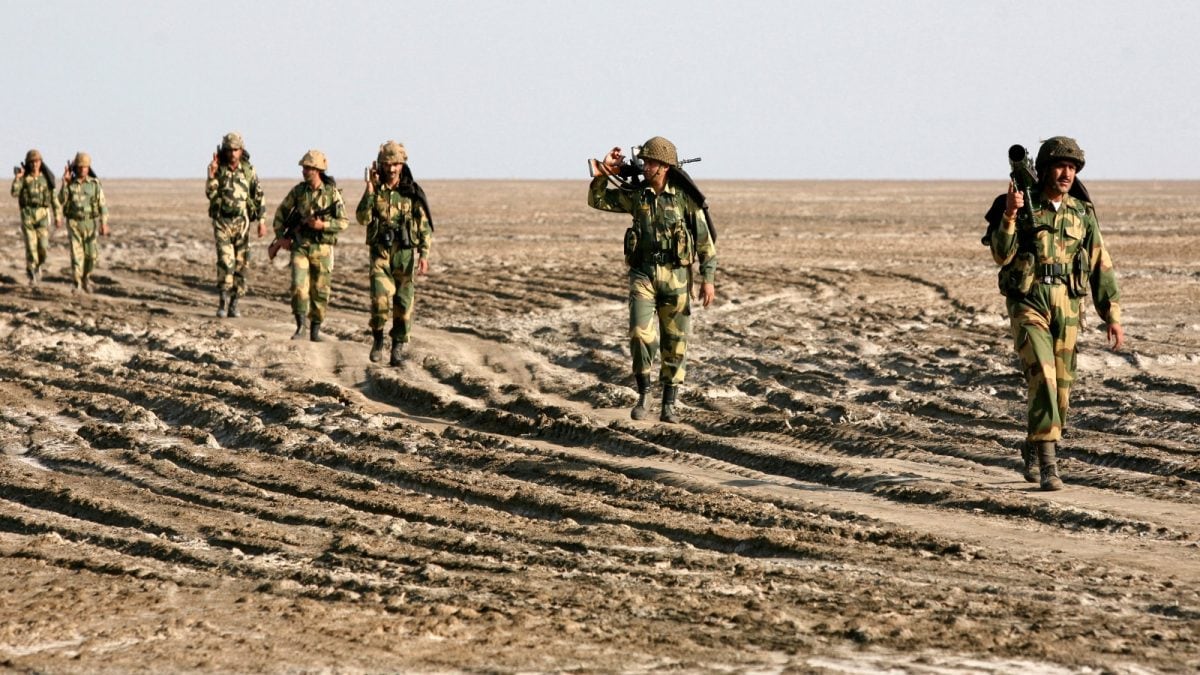Last Updated:
Rajnath Singh warned Pakistan against expanding military infrastructure in the bordering Sir Creek area, saying any move would be met with a decisive response

India’s Border Security Force soldiers patrol near the international border with Pakistan at Sir Creek, Gujarat, November 25, 2009. (REUTERS)
Sir Creek, a 96-km tidal estuary between Gujarat and Pakistan’s Sindh province, is back in the headlines after Defence Minister Rajnath Singh warned of a “decisive response” to Islamabad’s military build-up near the disputed border.
Here’s what the Sir Creek dispute is, why it remains unresolved, and what’s triggered its return to the spotlight.
Recommended Stories
Why Is Sir Creek Back In The Headlines?
The long-simmering Sir Creek dispute between India and Pakistan flared up on Thursday, when Defence Minister Rajnath Singh issued a sharp warning during Dussehra celebrations near Gujarat’s Bhuj. Accusing Pakistan of building up military infrastructure near the disputed border, Singh declared that any misadventure “will invite a decisive response that can alter both history and geography.”
Just a day later, top intelligence and naval sources confirmed to News18 that Pakistan has indeed significantly escalated its presence in the area, establishing mini-cantonments, emergency airstrips, new creek battalions, and reinforcing the Bholari airbase damaged in Operation Sindoor earlier this year.
Where Is Sir Creek And Why Is It Disputed?
Sir Creek is a 96-km-long tidal estuary situated in the marshlands between India’s Gujarat state and Pakistan’s Sindh province. It flows into the Arabian Sea through the Rann of Kutch, a vast, mostly uninhabited salt marsh, and forms part of the international boundary. The creek was named after a British colonial official and was originally part of the Bombay Presidency.
The dispute revolves around the demarcation of this watery boundary. Pakistan claims the entire creek belongs to it, based on a 1914 resolution issued by the then British-run Bombay Government, which it says places the border on the eastern bank, meaning the full creek lies in Sindh.
India disagrees. It says the same 1914 resolution also invokes the thalweg principle, an international legal concept that says boundaries in navigable water bodies should follow the deepest or mid-channel line. India further cites a 1925 map and mid-channel boundary pillars to back its claim, while Pakistan maintains that Sir Creek is a tidal estuary, not a river, and therefore the thalweg rule does not apply.
India counters that it remains navigable at high tide, so the principle should apply. The creek’s course also shifts over time, making the legal and cartographic dispute even more complicated.
What Did The 1968 Tribunal Say About Sir Creek?
In 1965, India and Pakistan fought a series of armed skirmishes in the Rann of Kutch region. To resolve the boundary dispute, both countries agreed to international arbitration. The case was heard by the Indo-Pakistani Western Boundary Case Tribunal, which gave its ruling in 1968.
The tribunal awarded nearly 90 per cent of the northern Rann of Kutch to India. However, it did not rule on Sir Creek. The tribunal focused on the boundary north of the creek, leaving the southern section, including the creek itself and its mouth, unsettled.
This leftover ambiguity created a situation where both countries interpret the land and maritime boundary differently, particularly in drawing their Exclusive Economic Zones (EEZs) and continental shelf claims in the Arabian Sea.
Why Is Sir Creek So Important?
On the surface, Sir Creek appears militarily unimportant — a swampy, uninhabited stretch prone to harsh weather, with scorching days and freezing nights. But despite its terrain, the region holds significant economic and strategic value. Control over Sir Creek affects the drawing of the maritime boundary in the Arabian Sea, which in turn determines access to Exclusive Economic Zones (EEZs), continental shelves, and suspected oil and gas reserves.
Moreover, the creek lies in one of the largest fishing zones in South Asia., and every year dozens of Indian and Pakistani fishermen are arrested for unintentionally crossing the unclear maritime boundary. Both nations have been criticised for keeping these civilians in jail for extended periods despite international norms that recommend minimal penalties for such violations.
Environmental concerns have added to the complexity. The Left Bank Outfall Drain (LBOD) canal from Pakistan allegedly discharges saline and industrial effluents into Sir Creek, which India sees as a violation of the Indus Waters Treaty.
What Has Pakistan Done Recently?
Pakistan has dramatically increased its military infrastructure in and around Sir Creek since India’s Operation Sindoor earlier this year. Four new Creek Battalions of the Sindh Regiment were added, taking the total to six. These include:
- 31st (Sujawal, 1999)
- 32nd (Gharo, 2019)
- 33rd (Badin, 2021)
- 34th (Jaati, 2025)
- 35th (Keti Bunder, 2025)
Each battalion has infantry and amphibious capabilities, with Pakistan Navy and Sindh Rangers providing full support. Pakistan has also set up six new marine security posts between Bandha Dhora and Harami Dhoro, deploying coastal defence boats, marine crafts, and patrol vessels.
The Bholari forward airbase, originally built to protect Chinese interests like the Thar coal project, was damaged in Indian strikes during Operation Sindoor but has since been reinforced with new air defence systems, JF-17 and J-10C squadrons, and surveillance technology, reportedly developed with Chinese assistance.
A joint military-naval-air command, established in 2021 with Beijing’s help, now oversees the region, with Pakistan deploying Chinese-made radars, AWACS aircraft, and missile systems for 24×7 monitoring.
What Did Rajnath Singh Say?
Speaking in Bhuj during Dussehra, Singh drew historical parallels to India’s 1965 offensive that reached Lahore. “In 2025, Pakistan must remember that the road to Karachi also passes through the creek,” he warned.
He accused Pakistan of harbouring “ill intentions” and said India’s efforts at dialogue have been met with duplicity. “We have tried to resolve this through talks several times, but Pakistan’s intent remains flawed. Now, if it dares to act, the reply will change both history and geography,” he said.
What Happened To Talks Over Sir Creek?
Diplomatic efforts to resolve the Sir Creek dispute have seen intermittent progress but no lasting breakthrough. Bilateral talks were last formally held in June 2012, focusing on both the land boundary and the maritime delimitation. A new Comprehensive Bilateral Dialogue was announced in December 2015, which included Sir Creek as an agenda item.
However, the 2016 Pathankot terror attack and Pakistan’s continued support for cross-border terrorism derailed the process. Since then, structured dialogue has remained suspended.
The Bottom Line
Sir Creek may look like an obscure marshland on the India–Pakistan border, but it carries weight far beyond its muddy banks. Control over this 96-km estuary influences maritime boundaries, fishing rights, and possible oil and gas reserves in the Arabian Sea.
With Pakistan stepping up military infrastructure and India warning of a “decisive response,” the decades-old dispute is no longer dormant.
About the Author

Karishma Jain, Chief Sub Editor at News18.com, writes and edits opinion pieces on a variety of subjects, including Indian politics and policy, culture and the arts, technology and social change. Follow her @kar…Read More
Karishma Jain, Chief Sub Editor at News18.com, writes and edits opinion pieces on a variety of subjects, including Indian politics and policy, culture and the arts, technology and social change. Follow her @kar… Read More
October 03, 2025, 16:03 IST
Loading comments…
Read More



